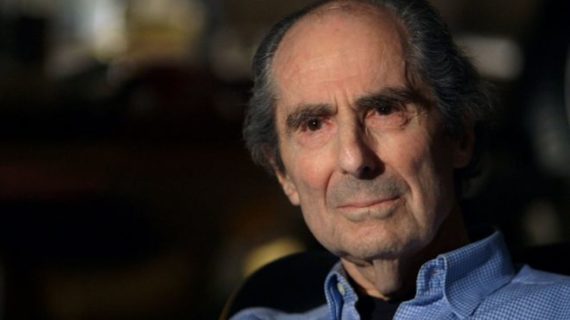Philip Roth, Prolific American Author, Dies At 85

Philip Roth, one of the greatest and most prolific authors of his generation, has died at the age of 85:
Philip Roth, the prolific, protean, and often blackly comic novelist who was a pre-eminent figure in 20th-century literature, died on Tuesday night at a hospital in Manhattan. He was 85.
The cause was congestive heart failure, said the writer Judith Thurman, a close friend. Mr. Roth had homes in Manhattan and Connecticut.
In the course of a very long career, Mr. Roth took on many guises — mainly versions of himself — in the exploration of what it means to be an American, a Jew, a writer, a man. He was a champion of Eastern European novelists like Ivan Klima and Bruno Schulz, and also a passionate student of American history and the American vernacular. And more than just about any other writer of his time he was tireless in his exploration of male sexuality. His creations include Alexander Portnoy, a teenager so libidinous he has sex with both his baseball mitt and the family dinner, and David Kepesh, a professor who turns into an exquisitely sensitive 155-pound female breast.
Mr. Roth was the last of the great white males: the triumvirate of writers — Saul Bellow and John Updike were the others — who towered over American letters in the second half of the 20th century. Outliving both and borne aloft by an extraordinary second wind, Mr. Roth wrote more novels than either of them. In 2005 he became only the third living writer (after Bellow and Eudora Welty) to have his books enshrined in the Library of America.
“Updike and Bellow hold their flashlights out into the world, reveal the world as it is now,” Mr. Roth once said. “I dig a hole and shine my flashlight into the hole.”
The Nobel Prize eluded Mr. Roth, but he won most of the other top honors: two National Book Awards, two National Book Critics Circle awards, three PEN/Faulkner Awards, a Pulitzer Prize and the Man Booker International Prize.
In his 60s, an age when many writers are winding down, he produced an exceptional sequence of historical novels — “American Pastoral,” “The Human Stain” and “I Married a Communist” — a product of his personal re-engagement with America and American themes. And starting with “Everyman” in 2006, when he was 73, he kept up a relentless book-a-year pace, publishing works that while not necessarily major were nevertheless fiercely intelligent and sharply observed. Their theme in one way or another was the ravages of age and mortality itself, and in publishing them Mr. Roth seemed to be defiantly staving off his own decline.
Mr. Roth was often lumped together with Bellow and Bernard Malamud as part of the “Hart, Schaffner & Marx of American letters,” but he resisted the label. “The epithet American-Jewish writer has no meaning for me,” he said. “If I’m not an American, I’m nothing.”
And yet, almost against his will sometimes, he was drawn again and again to writing about themes of Jewish identity, anti-Semitism and the Jewish experience in America. He returned often, especially in his later work, to the Weequahic neighborhood of Newark, where he grew up and which became in his writing a kind of vanished Eden: a place of middle-class pride, frugality, diligence and aspiration.
It was a place where no one was unaware “of the power to intimidate that emanated from the highest and lowest reaches of gentile America,” he wrote, and yet where being Jewish and being American were practically indistinguishable. Speaking of his father in “The Facts,” an autobiography, Mr. Roth said: “His repertoire has never been large: family, family, family, Newark, Newark, Newark, Jew, Jew, Jew. Somewhat like mine.”
More from The Washington Post:
Mr. Roth’s 1959 debut story collection, “Goodbye, Columbus,” earned him the first of two National Book Awards. He would go on to publish 27 novels, two memoirs and several more story collections by the time he publicly retired from writing in 2012. His lifelong themes included sex and desire, health and mortality, and Jewishness and its obligations — arguably his most definitive subject, given the controversy surrounding his earliest works.
In later years, his focus shifted more frankly to the nation and its discontents, from the rise of Richard Nixon as a political figure in the early Cold War era to the sideshow of the Clinton-Lewinsky scandal in what became known as Mr. Roth’s “American Trilogy”: “American Pastoral” (1997), “I Married a Communist” (1998) and “The Human Stain” (2000).
“He at once talked about America and American-ness, but filtered it through the history of the 20th century at large,” said Aimee Pozorski, an associate professor of English at Central Connecticut State University who had written extensively about Mr. Roth.
“He wrote about the American response to the Holocaust, but also about its effects in Israel and Central and Eastern Europe,” Pozorski said. “He talked about the spread of, and simultaneous fear of, communism in the U.S. but also considered cultural shifts in Prague during that time. He could write about these international issues because he was truly cosmopolitan, a global citizen who was grounded by American culture.”
She called Mr. Roth “the voice of his generation.”
A 2006 survey by the New York Times Book Review of the best books since 1981 found an astonishing six of Mr. Roth’s novels among the top 22. Well into his senior years, he continued to win the highest laurels of his profession with new, evocative works. In 1993, his “Operation Shylock: A Confession” won the prestigious PEN/Faulkner prize; in 1995, “Sabbath’s Theater” won the National Book Award; in 1997, “American Pastoral” won the Pulitzer Prize.
His appeal was not limited to elite critical circles, drawing such enthusiastic fans as Bruce Springsteen, the rock musician and fellow native New Jerseyan. Speaking of Mr. Roth’s “American Trilogy,” Springsteen once observed, “To be in his 60s making work that is so strong, so full of revelations about love and emotional pain, that’s the way to live your artistic life. Sustain, sustain, sustain.”
After “The Human Stain,” Mr. Roth sprinted to his career’s finish line with a remarkable decade-long kick. In short, he wrote seven more books.
(…)
Philip Milton Roth was born on March 19, 1933, to first-generation Americans — Herman Roth, an insurance salesman for Metropolitan Life, and his wife, the former Bess Finkel. They were Jews who “were and were not religious,” and they “didn’t talk about the past. There was no remembering elsewhere,” he recalled in “The Facts.”
He winced when referred to as an American Jewish writer. “Growing up Jewish as I did and growing up American seemed to me indistinguishable,” he wrote, also in “The Facts.” “I’d come from a small, safe, relatively happy provincial background — my Newark neighborhood in the thirties and forties was just a Jewish Terre Haute.”
Mr. Roth left Newark for Bucknell University in Pennsylvania mainly out of restlessness, to escape the familiar home town and his father, largely motivated by the younger Roth’s blooming rebellion.
“I wanted something difficult and dangerous to happen to me. I wanted a hard time. Well, I got it,” Mr. Roth said in 1984. (Explaining “Portnoy’s’ ” notoriety and his own in an essay titled “Imagining Jews” for the New York Review of Books in 1974, Mr. Roth wrote, “Going wild in public is the last thing in the world that a Jew is expected to do.”)
At Bucknell, he edited the literary magazine, was elected to the Phi Beta Kappa honor society and conscientiously began to find his writer’s voice, ruthlessly critiquing a colleague in print and discovering “a flash of talent for comic destruction.”
After graduating from Bucknell in 1954, he received a master’s degree in English the next year from the University of Chicago and served in the Army for a year (largely behind a desk in Washington.). He then returned to Chicago and taught English at his alma mater while writing fiction. An early admirer was novelist and future Nobel laureate Saul Bellow, who told an interviewer that Mr. Roth’s stories “showed a wonderful wit and great pace.”
In 1957, Mr. Roth’s short story “Defender of the Faith” was accepted by the New Yorker. The portrayal of a young Jewish soldier ignobly demanding religious loyalty from his Army superior — also Jewish — angered critics who worried about negative depictions of Jews.
When “Goodbye, Columbus” was accepted for publication in 1958, Mr. Roth resigned his teaching post and moved to Manhattan, but the friction with his antagonists wasn’t over.
In 1962, Mr. Roth shared a panel with “Invisible Man” author Ralph Ellison and Italian novelist Pietro di Donato during a symposium at Yeshiva University. Again he was denounced by questioners who thought he was undermining Jews. Mr. Roth later recycled the incident in “The Ghost Writer,” and he frequently said the standoff was formative.
In 1973, Mr. Roth explained the double-edged sword of those early attacks:
“I might turn out to be a bad artist, or no artist at all, but having declared myself for art — the art of Tolstoy, James, Flaubert, and Mann, whose appeal was as much in their heroic literary integrity as in their work — I imagined I had sealed myself off from being a morally unacceptable person, in others’ eyes as well as my own.
“I think now — I didn’t then — that this conflict with my Jewish critics was as valuable a struggle as I could have had at the outset of my career. . . . I resented how they read me, but I was never able to complain afterward that they didn’t read me; I never felt neglected.”
Mr. Roth married his first wife, Margaret Martinson, in 1959. They separated in 1963, and in 1968 Martinson died in an auto accident. The marriage was intensely difficult; Mr. Roth painted his wife as stifling and manipulative in “The Facts,” giving her the pseudonym of “Josie.” The marriage contributed to an extended period in the 1960s when the novelist said he was barely able to write. The gap from 1962 to 1967 was the longest he ever went between publishing.
A regimen of psychoanalysis led to the neurosis-filled “Portnoy,” the riotous tale of one young Jewish man’s anxiety and excessive masturbation. An early stab at the book was a play called “The Nice Jewish Boy,” which in 1964 had a trial reading at New York’s American Place Theatre with Dustin Hoffman. (The script didn’t work.)
“There’s always something behind a book to which it has no seeming connection, something invisible to the reader which has helped unleash the writer’s impulse,” Mr. Roth said of “Portnoy” in the 1984 collection “Writers at Work.” “I’m thinking about the rage and rebelliousness that were in the air, the vivid examples I saw around me of angry defiance and hysterical opposition. This gave me a few ideas for my act.”
Both of the above obituaries from The New York Times and The Washington Post go into far more detail about Roth long and prolific career, and I recommend both of them to your attention. In addition to those pieces, Dwight Garner has a lengthy appreciation of Roth’s work at The New York Times that begins with the observation that Roth’s death “marks, in its way, the end of a cultural era as definitively as the death of Pablo Picasso did in 1973.” Additionally, Alissa Williamson at Vox begins her eulogy to Roth with the observation that “Roth was one of the most important figures in modern American literature.” More appreciations of Roth’s work will be forthcoming I am sure, and literary critics and writers are likely to be discussing and referring to his work and his influence on the course of American literature in the years after World War II for many years to come.
While I cannot say that I have read everything Roth has written or even a majority of his work, I have read several of his works, starting in college when we were assigned both “Goodbye, Columbus” and “Portnoy’s Complaint” as part of an American literature class I was taking. In later years I also managed to read several other books, including 2004’s “The Plot Against America,” which amounted to Roth’s foray into the world of Alternative History and involved a world where Franklin Roosevelt was defeated in the 1940 Presidential election by Charles Lindbergh. As might be expected from that summary, the book explored ideas such as antisemitism and also drew heavily on Roth’s own experiences as a youth growing up in an American Jewish neighborhood in Newark, New Jersey. His last book, “Nemesis,” was written in 2010 and he told an interviewer in two years later that it would be his final book.
While Roth never achieved the fame or riches of popular fiction authors, his contributions to American culture are likely to be far longer standing than many of those people, and his writing will be sorely missed.






Who’s going to replace writers such as Roth and Wolfe? Will serious novelists even have any significance?
His writings took us from the specific to the universal by examining a small place and a particular people. Perhaps he should be compared to Faulkner for these reasons rather than just his co-religionists.
BTW, Pietro di Donato was an American whose novel Christ in Concrete deserves consideration.